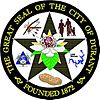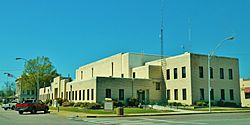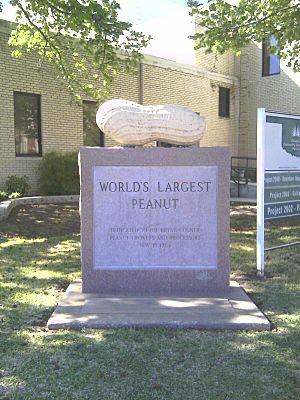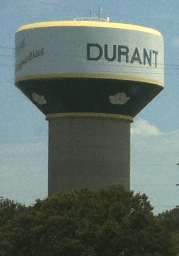Durant, Oklahoma facts for kids
Quick facts for kids
Durant, Oklahoma
|
||
|---|---|---|
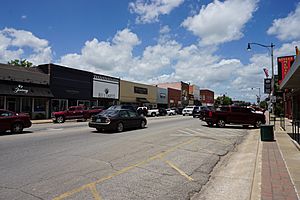
Main Street in Durant
|
||
|
||
| Nickname(s):
City of Magnolias and Gateway to Lake Texoma
|
||
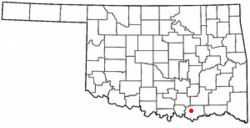
Location within the state of Oklahoma
|
||
| Country | United States | |
| State | Oklahoma | |
| County | Bryan | |
| Area | ||
| • Total | 26.76 sq mi (69.31 km2) | |
| • Land | 26.70 sq mi (69.14 km2) | |
| • Water | 0.06 sq mi (0.16 km2) | |
| Elevation | 636 ft (194 m) | |
| Population
(2010)
|
||
| • Total | 15,856 | |
| • Estimate
(2019)
|
18,673 | |
| • Density | 699.47/sq mi (270.07/km2) | |
| Time zone | UTC-6 (CST) | |
| • Summer (DST) | UTC-5 (CDT) | |
| ZIP codes |
74701-74702
|
|
| Area code(s) | 580 | |
| FIPS code | 40-22050 | |
| GNIS feature ID | 1092307 | |
Durant is a city in Bryan County, Oklahoma, United States and serves as the capital city and headquarters of the Choctaw Nation of Oklahoma. The population was 15,856 at the 2010 census. Durant is the principal city of the Durant Micropolitan Statistical Area, which had a population of 42,416 in 2010. Durant ranks as the second largest city within the Choctaw Nation, following McAlester, and ahead of Poteau. Durant is also part of the Dallas–Fort Worth Combined Statistical Area, anchoring the northern edge.
The city was founded by Dixon Durant, a Choctaw who lived in the area, after the MK&T railroad came through the Indian Territory in the early 1870s. It became the county seat of Bryan County in 1907 after Oklahoma statehood.
Durant is home to Southeastern Oklahoma State University and the headquarters of the Choctaw Nation. The city is officially known as the Magnolia Capital of Oklahoma. The city and its micropolitan are a major part of the Texoma region.
Contents
History
The Durant area was once claimed by both Spain and France before officially becoming part of the United States after the Louisiana Purchase and Adams–Onís Treaty. During the 1820s and 1830s the area was designated as part of the Choctaw Nation in the southern Indian Territory. During the Indian removals the Choctaws followed the Choctaw Trail of Tears from their ancestral homeland in Mississippi and Alabama into this area. The Choctaw Nation originally extended from the Mexican border in the west (now part of the Texas panhandle) to the Arkansas Territory in the east, from the Red River in the south to the South Canadian River in the north.
Pierre Durant and his four sons, all of French-Choctaw origin, made the journey up the Trail of Tears on the way to the southeastern part of the Choctaw Nation in 1832. The brothers, grown, with families of their own, established homesteads from the Arkansas line to Durant. One son, Fisher, married to a full-blood Choctaw, found a beautiful location for a home between Durant's present Eighth and Ninth avenues.
Fisher Durant's son Dixon Durant is recognized as the founder of Durant and is honored as its namesake. A minister, businessman and civic leader, Dixon Durant is credited with pastorates in local Presbyterian, Congregational and Methodist churches. He established the first store selling general merchandise in 1873, around the time of the 1872 creation of the Missouri–Kansas–Texas Railroad (Katy Railroad) siding at Durant, which was the initial impetus for establishing the community.
The first post office at the site was known as Durant Station, opening on February 20, 1879, and closing on July 11, 1881. A.E. Fulsom was postmaster. The U.S. Postal Service re-established the post office at the site as Durant on March 8, 1882, dropping the word "station" from the name.
W.H. Hilton was elected the first mayor of Durant.
A memorable event in Durant's rail history occurred on April 5, 1905. A special southbound Katy train stopped in the city with President Theodore Roosevelt aboard.
Bryan County was created from Choctaw lands in 1907, the same time as statehood, and was named after William Jennings Bryan. Bryan was nominated three times for President of the United States and at the age of 36 lost to William McKinley. He lost to McKinley again in 1900, and to William H. Taft in 1908. Woodrow Wilson appointed the county's namesake as United States Secretary of State in 1913.
Eleven people were killed in Durant by a tornado in April 1919.
The town's population grew from 2,969 in 1900 to 5,330 in 1910, 12,823 in 1990, and to 13,549 in 2000.
In 1953, actor José Ferrer and actress/singer Rosemary Clooney were married in Durant while Jose was performing in the musical Kiss Me, Kate in Dallas.
Geography
Durant is located in southern Oklahoma, in a region named Texoma, or Texomaland, because of its short distance from Lake Texoma. The city is also part of Kiamichi Country and Arbuckle Country. Its geographic coordinates are 33°59′59″N 96°23′5″W / 33.99972°N 96.38472°W (33.999834, −96.384825). It is approximately 14 miles (23 km) north of the Texas border at the Red River. Dallas is about 88 miles (142 km) south of Durant. The north edge of the Dallas–Fort Worth metroplex, in McKinney, is about 58 miles (93 km) to the south.
According to the United States Census Bureau, the city of Durant has a total area of 26.8 square miles (69.3 km2), of which 26.7 square miles (69.2 km2) is land and 0.077 square miles (0.2 km2), or 0.24%, is water.
Climate
| Climate data for Durant, Oklahoma | |||||||||||||
|---|---|---|---|---|---|---|---|---|---|---|---|---|---|
| Month | Jan | Feb | Mar | Apr | May | Jun | Jul | Aug | Sep | Oct | Nov | Dec | Year |
| Record high °F (°C) | 89 (32) |
93 (34) |
99 (37) |
97 (36) |
103 (39) |
107 (42) |
111 (44) |
118 (48) |
111 (44) |
100 (38) |
88 (31) |
87 (31) |
118 (48) |
| Average high °F (°C) | 53 (12) |
57 (14) |
66 (19) |
75 (24) |
82 (28) |
91 (33) |
95 (35) |
96 (36) |
89 (32) |
78 (26) |
65 (18) |
55 (13) |
75 (24) |
| Average low °F (°C) | 31 (−1) |
34 (1) |
42 (6) |
51 (11) |
59 (15) |
68 (20) |
71 (22) |
70 (21) |
63 (17) |
52 (11) |
41 (5) |
33 (1) |
51 (11) |
| Record low °F (°C) | −6 (−21) |
−4 (−20) |
−7 (−22) |
28 (−2) |
33 (1) |
46 (8) |
52 (11) |
50 (10) |
34 (1) |
16 (−9) |
9 (−13) |
5 (−15) |
−6 (−21) |
| Average precipitation inches (mm) | 2.2 (56) |
2.7 (69) |
2.9 (74) |
4.5 (110) |
5.4 (140) |
3.8 (97) |
3.2 (81) |
2.8 (71) |
3 (76) |
3.8 (97) |
2.6 (66) |
2.6 (66) |
39.5 (1,000) |
| Average snowfall inches (cm) | 1.2 (3.0) |
0.8 (2.0) |
0.3 (0.76) |
0 (0) |
0 (0) |
0 (0) |
0 (0) |
0 (0) |
0 (0) |
0 (0) |
0 (0) |
0.4 (1.0) |
2.7 (6.9) |
| Source 1: weather.com | |||||||||||||
| Source 2: Weatherbase.com | |||||||||||||
Demographics
| Historical population | |||
|---|---|---|---|
| Census | Pop. | %± | |
| 1900 | 2,969 | — | |
| 1910 | 5,330 | 79.5% | |
| 1920 | 7,340 | 37.7% | |
| 1930 | 7,463 | 1.7% | |
| 1940 | 10,027 | 34.4% | |
| 1950 | 10,541 | 5.1% | |
| 1960 | 10,467 | −0.7% | |
| 1970 | 11,118 | 6.2% | |
| 1980 | 11,972 | 7.7% | |
| 1990 | 12,823 | 7.1% | |
| 2000 | 13,549 | 5.7% | |
| 2010 | 15,856 | 17.0% | |
| 2020 | 18,589 | 17.2% | |
| Sources: | |||
As of the census of 2010, there were 15,856 people and 3,651 families residing in the city. The population density was 830 people per square mile (322/km2). There were 7,202 housing units. Nearly three fourths of the city's population (74.7%) self-identified as white, 13.3% self-identified as Native American, and 2.2% self-identified as black or African American. Less than a tenth of the population (7.1%) self-identified as Hispanic or Latino, regardless of race. Individuals of mixed Native American and white heritage accounted for 4.8% of the population. Less than 1% of the population was Asian or Pacific Islander.
Durant's first census was recorded in 1900, and the population was 2,969. The 2000 census reported Durant's population as 13,549.
There were 6,331 households in the city, of which 26% had children under the age of 18 living with them, 37.3% were married couples living together, 14.2% had a female householder with no husband present, and 42.3% were non-families. Individuals living alone accounted for 32.9% of households and 25.3% had someone living alone who was 65 years of age or older. The average household size was 2.34 and the average family size was 2.96.
In the city, the population was spread out, with 22% under the age of 18, 18.6% from 18 to 24, 24.8% from 25 to 44, 20.4% from 45 to 64, and 14.2% who were 65 years of age or older. The median age was 30.9 years. There were slightly more females (51.4% of the population) than males (48.6%).
The median income for a household in the city was $35,135, and the median income for a family was $41,014. Males working full-time had a median income of $34,040 versus $26,197 for female full-time workers. The per capita income for the city was $18,009. About 21% of families and 28% of the population were below the poverty line, including 35% of those under age 18 and 14% of those age 65 or over.
Arts and culture
Durant is home to the annual Magnolia Festival and the Three Valley Museum. The festival is put on by the Durant Chamber of Commerce and Durant Main Street Program the weekend following Memorial Day. It features music, shopping, shows, and two pageants - the Magnolia Pageant and the Choctaw Princess Pageant.
Durant has a "World's Largest Peanut" monument, a title it shares with two other monuments in Texas and Ashburn, Georgia. This monument to the peanut growers in Bryan County is located on the front lawn of Durant's city hall. Dedicated in 1973, it includes a time capsule that contains historic and legal documents, which will be unearthed in the year 2023.
The Three Valley Museum houses historical artifacts of Bryan County. Opened in 1976, it is named for a book about Durant, Queen of the Three Valleys by Henry McCreary, which references the city's location in the middle of the Red, Blue River, and Washita River valleys. The museum's exhibits include an early law office, doctor's office, child's room, parlor, and general store.
The Oklahoma Shakespearean Festival is housed on the campus of Southeastern Oklahoma State University. Oklahoma Shakespearean Festival is one of the top summer theatre festivals in America. It has made Durant and Southeastern Oklahoma State University a destination for tourists, professional and aspiring actors and theatre artisans.
Parks and recreation
The City of Durant maintains and operates 11 parks totaling more than 251 acres (1.02 km2). They include:
- Durant Multi-Sports Complex
- Dixon Durant Park – formerly Northside Park, or Rocket Park, renamed in honor of the founder of Durant.
- Carl Albert Memorial Park & public pool
- Billy Miller Park
- Schuler Park
- Lake Durant
Golf courses:
- Silverado Golf Course
Less than 10 miles (16 km) away, Lake Texoma has between 8–10 million visitors every year and is the 12th largest lake in the United States, and also one of the largest reservoirs in the country, contributing to Durant's economic and population growth.
Economy
Durant was ranked as the fastest growing rural city in Oklahoma in 2004, having the fastest growth rate outside of the Oklahoma City and Tulsa metropolitan areas.
Durant's daytime population increases to approximately 20,000 people. The city has a pull factor of 1.8–2.1 times its population and was named an All-American City finalist for 2006.
Since 1999, the Durant Economic Development Department, the Durant Industrial Authority and the City of Durant have developed over $600,000,000 in new investments to the city.
Durant currently leads the state in economic development. One of the city's strongest industries is tourism; attractions include Lake Texoma, the Choctaw Casino Resort, and Fort Washita. Manufacturing and distribution are growing industries in Durant with several factories being constructed and planned.
The largest employer in Durant is the Choctaw Nation of Oklahoma, including the Choctaw Nation Headquarters and the Choctaw Casino Resort, which has two Choctaw Travel Plazas, two Choctaw casinos, the Choctaw Inn, and more facilities that are located in the resort. Over 5,400 people work for the Choctaw Nation in Durant. Though the capital of the Choctaw Nation is recognized as being Tuskahoma, the administrative offices are located in Durant.
In 1894, Calvin Institute, a school for Native American youths, was established in Durant. By 1899, it had attracted an enrollment of 300. It was renamed Durant Presbyterian College in 1900 and Oklahoma Presbyterian College in 1910. The support for the school came from the Choctaw Nation of Oklahoma, the federal government, and several denominational missionary boards. Because of financial difficulties, the school was closed as a learning institution in the late 1960s. Chief Clark David Gardner established the Choctaw Nation administrative offices at the old Oklahoma Presbyterian College Building in 1975.
In 1976, in cooperation with the Durant Chamber of Commerce and the owners of the buildings, the Red River Valley Historical Association, title was transferred to the federal government. Ceremonies were held August 17, 1976, commemorating the title transfer. Reacquisition of this building allowed centralization of government which permits more effective utilization of personnel in administering current programs and developing future programs. The buildings has been renovated, and administration of many Choctaw programs are headquartered there.
Another important part of Durant's economy is the city's historic central business district and the retail district. In the past few years, downtown Durant has seen growth, renewal projects such as streetscaping, and new businesses arriving. Durant has a Main Street program. The retail district is west of downtown, at the intersection of U.S. 69/75 and U.S. 70, and is Durant's fastest growing area.
Cardinal Glass Industries has a float glass manufacturing facility in western Durant. It became operational in July 2004. This plant is number 20 for Cardinal Glass Industries.
Big Lots has a 1,200,000 sq ft (110,000 m2). distribution center in Durant that began operating in January 2004.
Durant is home to the headquarters of First United Bank, one of the largest privately owned banks in the United States, and First Texoma National Bank. Indian Nation Wholesale, also headquartered in Durant, was the 15th largest wholesaler in the United States as of 2008.
Wal-Mart opened a 195,000-square-foot (18,100 m2) supercenter in Durant in 2003, replacing the older, smaller Wal-Mart that had operated since 1986. Smaller grocery stores in Durant include Green Spray and Pruett's Grocery Store.
Sports
Although no major sports team is located in Durant, many sporting opportunities are found in the city, including the Durant Multi-Sports Complex, golf, soccer pitches, and baseball fields.
The Durant Multi-Sports Complex is an athletic facility located 2 mi (3 km) southeast of Durant, on Highway 78. The sports complex, dedicated on November 17, 2006, sits on 80 acres (32 ha), with 100 acres (40 ha) undeveloped. It consists of baseball and softball fields, soccer pitches, and a football stadium/track field. A 17-acre (69,000 m2) lake is under construction, and a walking and biking trail is planned to be built around the lake. The cost of the complex was $7 million.
Education
Higher education
Durant is home to Southeastern Oklahoma State University, which has about 5,200 enrolled students. It is the only university in Oklahoma to offer a Master of Science in Aviation and Space. Southeastern Oklahoma State University offers degrees through its Aviation Sciences Institute, the largest aviation program in the state. The main campus in Durant has facilities at the airport to support flight training and facilities on campus to facilitate the management options in business, maintenance, safety, and security. The institute offers the undergraduate management degrees as well as the Master of Science degree in Aerospace Administration & Logistics.
Southeastern Oklahoma State University also offers a doctoral degree, Ed.D., in Applied Educational Studies with the Aviation and Space Science specialization and a Graduate Certificate in Aviation Security.
Career and technical education
Durant is home to the Kiamichi Technology Center, which has eight other locations in southeastern Oklahoma. Kiamichi is part of the Oklahoma Department of Career and Technology Education.
Elementary and secondary
The Durant Independent School District is the largest school district in southeastern Oklahoma and serves approximately 3,100 students. The district includes six schools and includes preschool, primary and secondary education.
The region is also home to the Silo School District, which includes three schools and serves approximately 680 students, and to one of two schools in the Rock Creek School District.
The city has a private K-12 school, Victory Life Academy, which has an enrollment of about 250 students.
Infrastructure
Roads and highways
US 69/US 75 – A north-south four-lane divided highway and freeway. US 69/75 enters Oklahoma as a freeway from the Dallas area. It then downgrades to a divided four-lane highway just north of Colbert. The highway then enters Durant from the south. After its at-grade intersection with Choctaw Road, it again upgrades to a freeway, passing through western and northern Durant, and again downgrades to a four-lane divided highway at the Bryan-Atoka County line.
US 70 – An east–west route. Highway 70 enters Durant from the east as a two-lane highway as Mulberry Street, crossing a Union Pacific railroad via a bridge. It then heads southward toward downtown on First Avenue as a 3-lane, concurrent with SH 78 and Business Routes 69/75. Downtown it has an intersection with Main Street, then continues its route westward on West Main Street concurrent with Business Routes 69/75. Just west of downtown it turns into a three-lane street, and after its intersection with 9th Avenue it converts into a 5-lane street. At Washington Avenue it downgrades to a two-lane again while it travels through West End Heights, a historic and upscale neighborhood. At 21st Avenue it turns into a divided four-lane highway in the Retail District, intersecting with 69/75 as a parclo interchange. Highway 70 continues westward toward Mead and Lake Texoma as a 5-lane highway.
SH 78 – A north–south route. SH 78 enters Durant from the south as Southeast 3rd Avenue and as a two-lane. It comes to an intersection with East Main Street and turns westward toward downtown continuing its route. At the intersection of Main and First Avenue, the highway turns northward onto First Avenue as a 3-lane street, concurrent with Highway 70 and Business Routes 69/75. It continues northward to University Boulevard and turns into a two-lane highway. Just before its intersection with 69/75 (via ramps), SH 78 turns into a divided four-lane highway for a short time and then turns into a two-lane highway again, exiting the city.
Intercity bus service is provided by Greyhound Lines.
In a 2006 study by the Oklahoma Department of Transportation, an average of about 19,100 vehicles pass Durant's Main Street on U.S. 69/75 every day. Approximately 19,000 vehicles pass under 69/75 on Main Street daily.
The major streets are First Avenue, Southeast 3rd Avenue, South 9th Avenue, Washington Avenue, Radio Road, University Place, 49th Avenue, Choctaw Road, Rodeo Road, West Main Street, East Main Street, University Boulevard, Chuckwa Street, Gail Farrell Drive, and Mockingbird Lane.
There are four exits in Durant from U.S. 69/75, at First Avenue, Washington Avenue, University/Chuckwa (the exit off northbound 69/75 is the only one complete), and Main Street. There are also traffic lights at the intersection of U.S. 69/75 and Choctaw Road south of Durant, where the Choctaw Casino Resort is located.
Airports
Durant Regional Airport – Eaker Field, the city's airport, and home to Southeastern Oklahoma State University's Aviation Sciences Institute, was a U.S. Navy auxiliary airfield during World War II. It is named after U.S. Army Air Force General Ira C. Eaker, early commander of the legendary Eighth Air Force in wartime England, who graduated from the university (then known as Southeastern State Teacher's College) in 1917.
The closest international airports to Durant are Dallas/Fort Worth International Airport and Will Rogers World Airport in Oklahoma City.
Rail
Durant is a major railroad center. The giant Union Pacific Railroad and the short-line Kiamichi Railroad intersect in downtown.
Utilities
Durant is served by a city-owned water plant and sewage treatment center. Residents receive electricity from OG&E and Southeastern Electric Co-op.
Healthcare
Durant is served by AllianceHealth Durant, which was formerly the Medical Center of Southeastern Oklahoma. Built in 1987, the medical center replaced the Bryan Memorial Hospital.
Emergency Medical Services are provided by Bryan County EMS.
Notable people
- Brett Butler, professional baseball player, attended Southeastern Oklahoma State University
- Mike Christian, state representative, attended University of Oklahoma
- Joe Dobson, Major League Baseball pitcher, 1948 American League All-Star, inducted in Boston Red Sox Hall of Fame
- Gail Farrell, cast member of The Lawrence Welk Show; Gail Farrell Drive, avenue located on far north side of city, named in her honor in mid-1970s
- Ralph Faudree, mathematician and provost of the University of Memphis
- Billie Letts, author
- Tracy Letts, playwright and actor
- Reba McEntire, recording artist, Grammy Award-winning singer and actress, attended Southeastern Oklahoma State University
- Kirby Minter, retired basketball player, played for Team USA in 1954 FIBA World Championship in Rio de Janeiro
- Dennis Rodman, professional basketball player, attended Southeastern Oklahoma State University
- Robert L. Williams, first Chief Justice of Oklahoma Supreme Court, third Governor of Oklahoma, U.S. district and appellate judge
Images for kids
See also
 In Spanish: Durant (Oklahoma) para niños
In Spanish: Durant (Oklahoma) para niños


